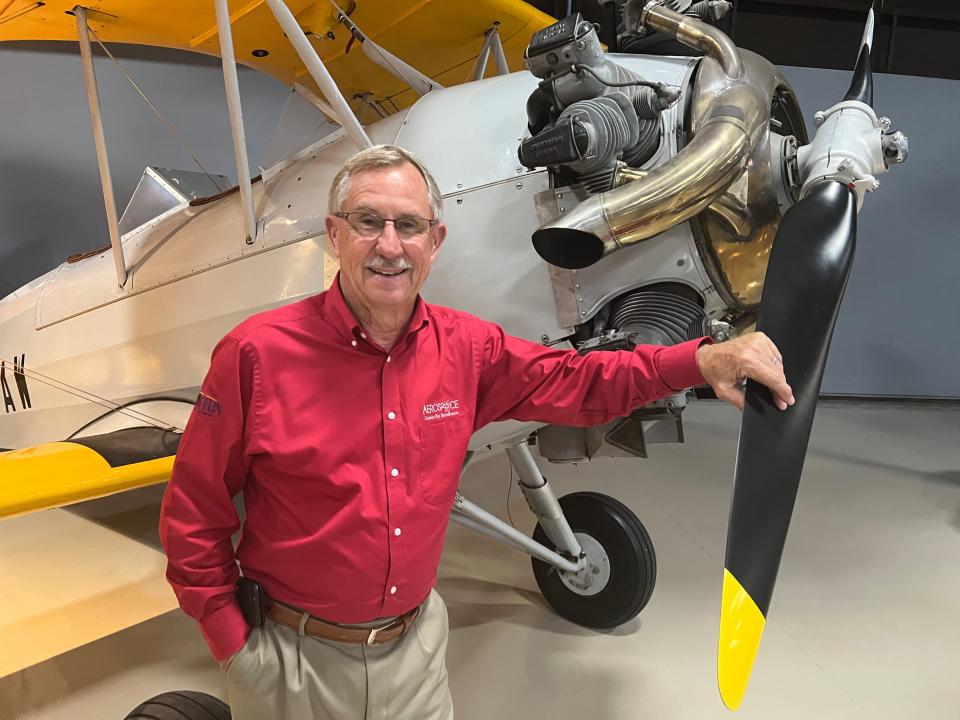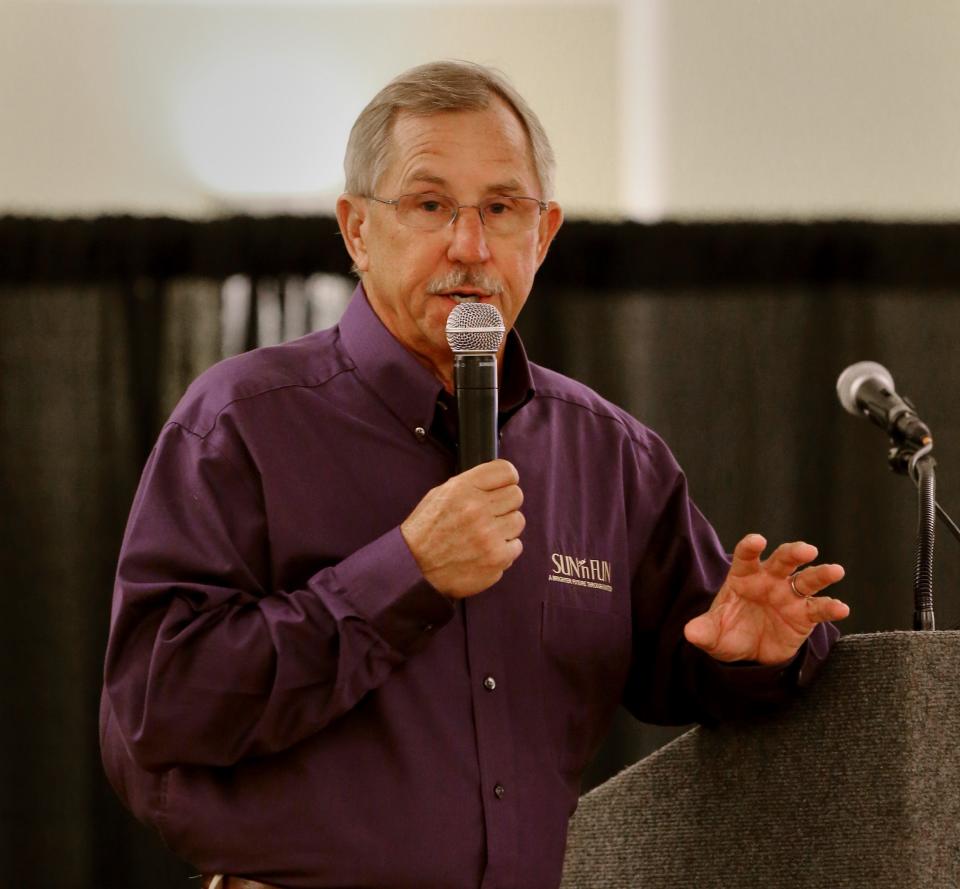'Nothing better than changing young lives': John Leenhouts reflects on his legacy at Sun 'n Fun
In the pantheon of aviation overachievers, John “Lites” Leenhouts occupies a unique place.
He holds the U.S. Navy’s pilot-in-command record for most aircraft carrier “traps” — parlance denoting a plane’s tailhook snagging the arresting wire running athwart the flight deck — 1,645 times. The runner-up is 19 traps short with no possibility of catching up, having left both the service and this life. Of Leenhouts’ total, 425 came at night. He walked away from them all — “a good landing” — and claims the aircraft he piloted remained fully functional, which in aviation mythology qualifies as a “great landing.”

After 27 years as a naval aviator, Leenhouts became an executive at Northrop for a period before beating out 179 other applicants to become president of Sun ‘n Fun in late 2011. Having turned around an organization heading for bankruptcy and accelerating its mission to greater altitudes, following next week’s event the 71-year-old aviator says he will retire for good.
Will Amazon get in the way of Sun 'n Fun? Amazon jets will takeoff, land during 2022 Sun 'n Fun air shows
Stepping down: 'Shooting star' John 'Lites' Leenhouts to step down from leading Sun 'n Fun expo
Sun 'n Fun 2022: Your guide to 2022 Sun 'n Fun Aerospace Expo
Q. When were you bit by the aviation bug?
A. When I was about 16, I hitchhiked to Carswell Air Force Base in Fort Worth, Texas, where they had an air show. I was looking at all these cool military aircraft and thinking no way was that going to be in my future. I ended up having a conversation with a gentleman in a flight suit standing by an F-100 Super Sabre and that spawned in my brain the idea that maybe I could do this. I ended up learning to fly at Oklahoma State University in the early '70s when one day a T-34B arrived. A Navy pilot gets out, and I’m thinking, “That’s one cool dude — I’ve got be that guy.”
Q. Do you have a favorite airplane?
A. It’s always the one I’m flying right now, but at the end of the day the most exciting airplane you’re ever going to be able to fly is the F-18 Hornet, for multiple reasons — massive amounts of power, a great design, incredible flexibility and more importantly, instead of an engineer designing the cockpit layout, they had pilots doing it. Up till that time the engineers just put stuff wherever it fit.
Q. Every call sign has a story. How did “Lites” come about?
A. You don’t pick it — you’re given it, forced upon you. The more you fight it, the harder it sticks. A part of my Navy career included public affairs, so I carried a camera and it became “lights, camera, action” and that evolved into just “Lites” for the rest of my career. Most of us who have worked together don’t know each other’s first names — we’re just “Rat” or “Animal” or “Bong” or “Hurricane” or whatever our call signs were.
Q. What’s the closest you came to buying the farm?
A. In one case it was in a Tomcat. My buddy was flying a Tomcat and we both inadvertently go after the same airplane we’re trying to gun down in a war game when it made an unpredictable move and we ended up crossing canopy-to-canopy feet apart at closing speeds of over 1,000 miles an hour. I had another one with the same guy, believe it or not, flying A-7s, crossing paths over a ship. I was about 25 feet over the deck, he about 100. For us it was terrifying. For those on the ship it was probably the coolest airshow they’d ever seen.
Q. What were your expectations when you took over as chief executive of Sun ‘n Fun?
A. I’d been coming here since 1981 when I first came as a participant. When I got here as president I thought I knew how it works. Up until 2012, this was a one-week wonder. We had an airshow and that was it. I quickly realized this place was hosed up. We were $2.8 million in the hole and you can’t live like that. They’d borrow to pay the employees until the fly-in and then pay that off and borrow again. We’re a non-profit but it doesn't mean you have to be a failing non-profit.
We went to work on turning this into an event venue. We had to start doing things — birthdays, bar mitzvahs, wedding showers. I don’t care if it’s five people, if they’re willing to pay, they’re coming out here. Having done that, now we’re over 80 events a year, many quite substantial — car shows, dog shows, RV shows, extreme runs, balloon fests.
We’ve had a constant increase in revenue over the last 10 years. The value of our assets in 2011 was $10 million, but we were nearly $3 million in debt. Today we have $1.5 million in the bank, $1 million in an endowment — which we never had before — and all the rest of our assets and operating cash total $22 million, with no debt.
Q. What are you anticipating the numbers to be for the upcoming fly-in?
A. We’re expecting over 230,000 people over the six days, counting every person who’s here, probably about 3,500 aircraft and 500 exhibitors who will be selling product, plus 35 different food vendors.
'A little bigger, a little better': Exclusive 9/27 Club tickets at Sun 'n Fun going fast
Q. When you’re running the busiest airport in the world for a week, how do you address safety issues?
A. I don’t preach safety, I preach professionalism at every level. Safety is the byproduct. We have a series of meetings and I talk about the flight path for success. We have rules and regulations and procedures. If you start adlibbing, things go to hell in a handbasket. Everybody here has a red flag. If you see something, stop it. The goal is to get everyone’s mentality to be a professional.

Q. Given all that this organization does, what do your studies show the economic impact to be?
A. We are a $249 million economic engine for the region on an annual basis, direct and indirect. In 2012, we started on a scholarship program for high school students who wanted to learn to fly. When we started that program there were no flight schools in Lakeland. Once we got it going, and people heard we were doling out tens of thousands of dollars annually, other flight schools started arriving. We’ve got five on the field now. When you get the flight schools, you get instructors, dispatchers, mechanics. Then you get a lot of flight operations. More people start flying and the federal government decides to improve the infrastructure. Plus you have a high school turning out the next round of employees. Then Amazon comes in.
Q. As I understand it, the fly-in is structured as a nonprofit and your secondary mission is to support the Aerospace Center for Excellence.
A. Actually, you’ve got it backward. It was what you described until 2014, when we started the transition, which is a 25-acre ecosystem to go from grade school all the way through a career. We have in place all the tenets of learning the business and the skill sets to succeed in the aviation industry. By 2016, we were up and running and in 2019 we flipped — Sun ‘n Fun became a fundraiser for the Aerospace Center for Excellence.
Q. What is the primary mission of ACE?
A. We are designed as an extension of the Polk County public school system. Our goal here is to engage, educate and accelerate the next generation of aerospace professionals. How do we do that? We have a facility that has all of the advanced science and technology in it and the schools send their students here to the laboratory. They take the knowledge they’ve gained in the classroom and apply the theory to real application here. Our goal is to be able to bring every student in Polk County through our facility at least once a year.
Q. How many career paths can be pursued at your full-time ACE high school?
A. Our school has six tracks — professional pilot, aerospace engineer, aircraft mechanic, unmanned air systems, aviation technology and business management. All those are designed to let that young man or woman get ahead faster. Our goal is to get them exposed to the sciences, hope they pick up aviation as a career. But at the end of the day, our vision is a brighter future through education, so that everyone we engage becomes an asset to society.
Q. How do you measure success?
A. There are 365 kids in the school right now, and over 425 will be here next year. Our alumni is illustrious. When they graduate they go into college, the military or right into the work force — with skills. We have had kids who are now military pilots, military mechanics, airline captains, working in the FAA, another who is an engineer for Space X. When all is said and done, if you walk away from our aviation ecosystem here and you add to society as a functioning human being, then we have been successful.
We work really hard to create opportunity for young men and women to see things they never thought possible could happen in their lives. We give them the tools to go out and give them a boost to accelerate them on the flight path of life and get them to become the next generation that leads America into the future.
There’s nothing better than changing young lives. I looked back and thought of my own. I was going to be throwing hay bales on the back of a flatbed truck in the middle of Kansas if I didn’t get into airplanes. It changed everything. I thought why not give that opportunity to the youth of this area, show them how to do it. What I’m most proud of is that we’re changing lives for the better — and we’re doing it by the hundreds.
Thomas R. Oldt can be reached at tom@troldt.com.
This article originally appeared on The Ledger: Head of Lakeland's Sun 'n Fun expo reflects on aviation, airshow

